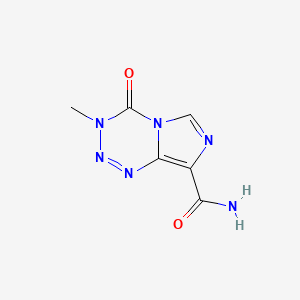


| Pair Name | Resveratrol, Temozolomide | ||
| Phytochemical Name | Resveratrol (PubChem CID: 445154 ) | ||
| Anticancer drug Name | Temozolomide (PubChem CID: 5394 ) | ||
| Structure of Phytochemical |

|
Download
2D
MOL
3D
MOL
|
|
| Structure of Anticancer Drug |

|
Download
2D
MOL
3D
MOL
|
|
| Pair Name | Resveratrol, Temozolomide | |||
| Disease Info | [ICD-11: 2A00] | Glioblastoma multiforme | Investigative | |
| Biological Phenomena | Induction-->Apoptosis | |||
| Gene Regulation | Down-regulation | Expression | MGMT | hsa4255 |
| Down-regulation | Expression | STAT3 | hsa6774 | |
| Up-regulation | Expression | PIAS3 | hsa10401 | |
| Up-regulation | Expression | PTPN6 | hsa5777 | |
| Up-regulation | Expression | PTPN11 | hsa5781 | |
| Up-regulation | Expression | SOCS3 | hsa9021 | |
| In Vitro Model | A-172 | Glioblastoma | Homo sapiens (Human) | CVCL_0131 |
| LN-428 | Glioblastoma | Homo sapiens (Human) | CVCL_3959 | |
| Result | Res inhibited STAT3 signaling through modulation of PIAS3, SHP1, SHP2, and SOCS3, thereby attenuating tumor growth and increasing sensitivity to TMZ. Therefore, Res is an ideal candidate to be used in TMZ combined chemotherapy for GBM. | |||
| Pair Name | Resveratrol, Temozolomide | |||
| Disease Info | [ICD-11: 2A00] | Glioblastoma multiforme | Investigative | |
| Biological Phenomena | Induction-->Apoptosis | |||
| Gene Regulation | Down-regulation | Activity | MGMT | hsa4255 |
| Down-regulation | Phosphorylation | STAT3 | hsa6774 | |
| Down-regulation | Expression | BCL2 | hsa596 | |
| Down-regulation | Expression | BIRC5 | hsa332 | |
| In Vitro Model | RG2 | Malignant glioma | Rattus norvegicus (Rat) | CVCL_3581 |
| LN-18 | Glioblastoma | Homo sapiens (Human) | CVCL_0392 | |
| LN-428 | Glioblastoma | Homo sapiens (Human) | CVCL_3959 | |
| Result | Our results demonstrated synergistic effects of Res/TMZ on RG-2 cells and their bilaterally sensitizing effects to LN-18 and LN-428 cells. Frequent upregulation of MGMT and activation of STAT3 are the unfavorable factors for the treatment of GBMs and they may be the potential targets of Res/TMZ therapy. | |||
| Pair Name | Resveratrol, Temozolomide | |||
| Disease Info | [ICD-11: 2F7Z] | Glioma | Investigative | |
| Biological Phenomena | Inhibition-->Autophagy | |||
| Gene Regulation | Down-regulation | Phosphorylation | MAPK1 | hsa5594 |
| Down-regulation | Expression | MAP1LC3B | hsa81631 | |
| Up-regulation | Cleavage | PARP1 | hsa142 | |
| In Vitro Model | U-87MG ATCC | Glioblastoma | Homo sapiens (Human) | CVCL_0022 |
| In Vivo Model | U87 MG cells in 0.1 ml MEM were subcutaneously (s.c.) injected into the right hind flank of the mice. Tumor sizes were measured with a caliper and were calculated as 1/2 × length × width2 in mm3. When the tumors grew to about 100 mm3, the tumor-bearing mice were randomly separated into treatment groups (n = 6/group). | |||
| Result | TMZ-induced ROS/ERK-mediated autophagy protected glioma cells from apoptosis, and the combination of resveratrol with TMZ could improve the efficacy of chemotherapy for brain tumors. | |||
| Pair Name | Resveratrol, Temozolomide | |||
| Disease Info | [ICD-11: 2F7Z] | Glioma | Investigative | |
| Biological Phenomena | Induction-->ROS-dependent AMPK-TSC-mTOR signaling pathway | |||
| Gene Regulation | Down-regulation | Expression | BCL2 | hsa596 |
| Up-regulation | Expression | BAX | hsa581 | |
| Up-regulation | Phosphorylation | TP53 | hsa7157 | |
| Up-regulation | Expression | CASP3 | hsa836 | |
| Up-regulation | Expression | CASP7 | hsa840 | |
| Up-regulation | Expression | CASP9 | hsa842 | |
| Down-regulation | Expression | CCNB1 | hsa891 | |
| Down-regulation | Expression | LRRC59 | hsa55379 | |
| Down-regulation | Expression | CDKN1A | hsa1026 | |
| Down-regulation | Activity | MAPK14 | hsa1432 | |
| Down-regulation | Activity | MAPK8 | hsa5599 | |
| Down-regulation | Activity | MAPK1 | hsa5594 | |
| In Vitro Model | SHG-44 | Astrocytoma | Homo sapiens (Human) | CVCL_6728 |
| In Vivo Model | SHG44 cells (5×10⁵ cells per mouse) in 5 μL of Hanks’ solution were injected intracranially into the right caudate nucleus of 6‐ to 8‐week‐old female nude mice using a screw guide technique as described | |||
| Result | TMZ in combination with resveratrol remarkably increased reactive oxygen species (ROS) production, which serves as an upstream signal for AMP-activated protein kinase (AMPK) activation. Subsequently, activated AMPK inhibited mTOR signaling and downregulated antiapoptosis protein Bcl-2, which was contributed to the additive antiproliferation effects of combination treatment. In an orthotopic xenograft model of GBM, TMZ plus resveratrol treatment significantly reduced the volume of tumor, which was confirmed by decreased expression of Ki-67, a marker of proliferation index | |||
| No. | Title | Href |
|---|---|---|
| 1 | Resveratrol Enhances Temozolomide Efficacy in Glioblastoma Cells through Downregulated MGMT and Negative Regulators-Related STAT3 Inactivation. Int J Mol Sci. 2023 May 29;24(11):9453. doi: 10.3390/ijms24119453. | Click |
| 2 | Synergistic Effects of Resveratrol and Temozolomide Against Glioblastoma Cells: Underlying Mechanism and Therapeutic Implications. Cancer Manag Res. 2020 Sep 11;12:8341-8354. doi: 10.2147/CMAR.S258584. | Click |
| 3 | Resveratrol enhances the therapeutic effect of temozolomide against malignant glioma in vitro and in vivo by inhibiting autophagy. Free Radic Biol Med. 2012;52(2):377-391. doi:10.1016/j.freeradbiomed.2011.10.487 | Click |
| 4 | Resveratrol enhances the antitumor effects of temozolomide in glioblastoma via ROS-dependent AMPK-TSC-mTOR signaling pathway. CNS Neurosci Ther. 2012;18(7):536-546. doi:10.1111/j.1755-5949.2012.00319.x | Click |
